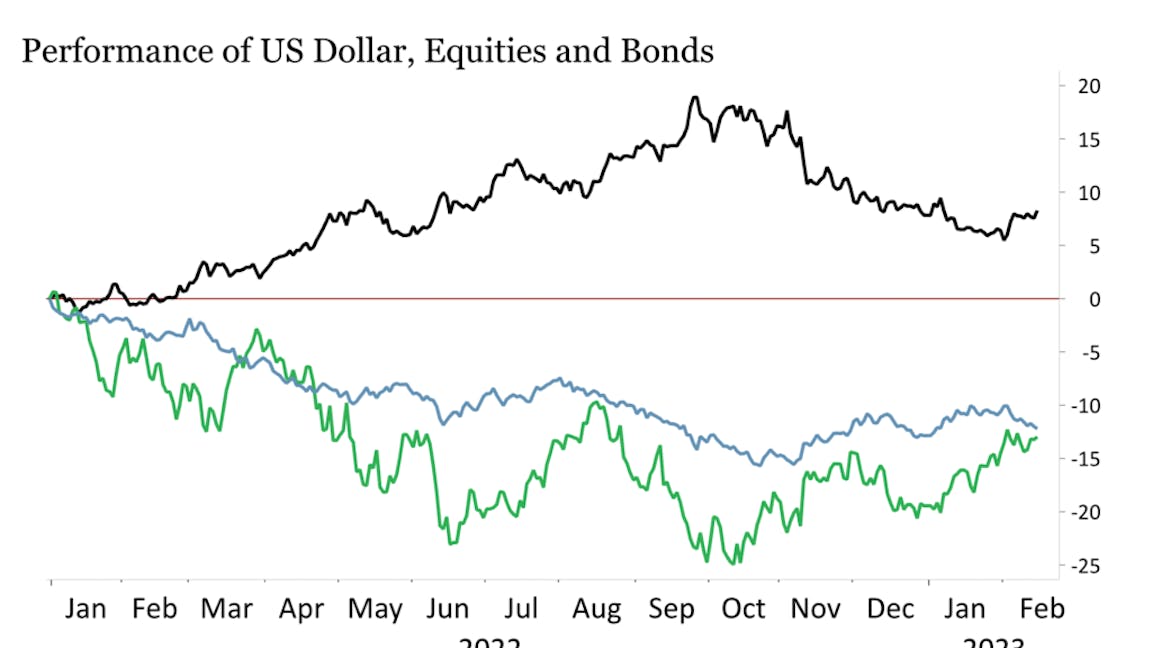
The US dollar is the world’s reserve currency. It facilitates global trade, is integral to international business and supports the functioning of the broader economy. The euro, the Japanese yen and pound sterling are also major currencies, but none reign supreme as the dollar, which accounts for around 60% of central bank foreign currency reserves.
What’s the impact of a strong currency?
When you travel abroad, the exchange rate (the relative value of two currencies) might be a nice surprise or a nasty shock. Currency movements impact exchange rates, and have a downstream impact on economies, businesses and investors too, making financial conditions easier or more challenging.
In 2022, the dollar rose to highs not seen in decades. It reached a 20-year high against the euro, a 30-year high against the yen, and a 40-year high against the pound. This impacted assets, businesses and economies in different ways. In the US, domestically focused companies were well-placed to take advantage of the stronger dollar. Multinationals like IBM – that generate a big proportion of their revenue internationally – found their earnings impacted. This impacted assets, businesses, and economies in different ways. In the US, domestically focused companies were well placed to take advantage of the stronger dollar. Multinationals like IBM – that generate a big proportion of their revenue abroad – found their earnings impacted.
Outside of the US, some international companies benefitted from a stronger dollar and a weaker local currency. The FTSE 100, for example, benefits from sterling weakness against the dollar, as most the index’s largest companies earn a significant proportion of their revenue abroad and therefore have relatively small exposure to the domestic market. The businesses which reported their earnings and dividends in dollars and then converted them back to sterling experienced noticeable gains.
Why did the dollar rise so dramatically in 2022?
Currencies can rise or fall because of changes in inflation, interest rates, politics and the broader economy.
In 2022, the dollar rose as investors sought a ‘safe haven’ when confronted by rising inflation in western economies. The Federal Reserve (the US central bank) and other central banks aggressively tightened monetary policy in response, incentivising investors to pivot away from riskier assets. The higher dollar drove down the value of other currencies around the world, many of which were already under pressure and losing purchasing power due to the rise in inflation.
This created a headwind for the global economy and put pressure on the price of assets outside of the US. It also contributed to higher costs, which raised inflation outside of the US (known as ‘importing inflation’) and made debt repayments harder in developing countries. Emerging markets bore the brunt of the higher dollar, with
The chart below shows how a stronger dollar affected equities and bonds in 2022. As the dollar rose, the value of equities and bonds fell. In November, the trend slowly started to reverse, as markets became more optimistic that inflation was falling and interest rate hikes would soon pause.
Chart 1. Performance of the US dollar index vs. the S&P 500 index and the US government bond index, baselined to January 2022 and expressed in % terms (January 2022-January 2023)

Why might the dollar move lower in 2023?
A weaker dollar has the opposite effect of a stronger dollar. It relaxes financial conditions, gives the global economy room to breathe, and supports equities and fixed income by making international trade and debt repayment easier for business and economies.
Emerging markets stand to be the main beneficiary of a weaker dollar, as they will feel the effect twofold: directly on their currencies and on their dollar-denominated bonds.
We see three reasons why the dollar will decline in 2023.
1. The Federal Reserve should pause interest rate hikes
We think the dollar will weaken as the Federal Reserve reaches its terminal rate and pauses its interest rate hikes. (The ‘terminal rate’ is the peak rate of interest, meaning it is not expected to go any higher.)
Once the bank communicates that its “current policy stance is adequate” (meaning it has finished raising interest rates), equity and fixed income investors should experience a confidence boost, as uncertainty on the future direction of policy and interest rates will be reduced.
It’s expected that other central banks (like the European Central Bank and the Bank of England) will carry on raising rates until they have brought inflation down to a more desirable level. This will improve the attractiveness of these currencies and bonds because the interest rates will be higher.
2. Inflation is slowing down
Across the western world, While ‘core’ inflation will remain elevated due to higher wages and rents, the price of energy and goods (the main drivers of inflation) is easing. The stabilisation of inflation around the world leads to improving financial conditions which in turn should see the dollar fall against other major currencies and an appreciation in asset prices.
3. Global financial conditions appear to be stabilising
Geopolitical volatility spiked last year when Russia invaded Ukraine. Markets and economies spent the rest of the year dealing with the fallout while still grappling with the aftermath of Covid, which led to tighter monetary policy. Global trade recovered as businesses and economies adjusted their supply chains. Meanwhile, China stuck to its zero-covid policy.
The gradual reopening of China this year is a cause for optimism and is expected to provide a boost to other emerging markets and some western economies. Increased trade and an easing of monetary policy by the People’s Bank of China should improve liquidity (the amount of dollars moving around the world) and help ease the tightening conditions we saw throughout 2022.
The stabilisation of global conditions is welcome and supports the weakening of the US dollar – and in turn asset prices.
The Nutmeg view
We think the dollar’s decline will be a tailwind for global markets in 2023, with emerging markets set to benefit the most. A weaker dollar will support and reflect the normalisation and stabilisation of economic conditions around the world, which should support the performance of equities and bonds.
Risk warning
As with all investing, your capital is at risk. The value of your portfolio with Nutmeg can go down as well as up and you may get back less than you invest. Past performance is not a reliable indicator of future performance.
